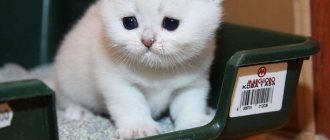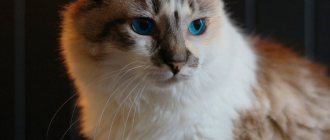- Cats
Bombay cats, or simply Bombays, can be purchased in Russian or foreign clubs and nurseries. Bombays are also sold by private owners who do not have official permission to breed this breed of cats, but still do it accidentally or planned.
A Bombay kitten is inexpensive compared to many other breeds. Private owners sell Bombays for an average of 5-7 thousand rubles, and the cost of kittens in nurseries starts from 20,000 rubles. In clubs, the minimum price threshold is slightly lower - 15-17 thousand rubles. The cost of kittens varies depending on their age, appearance, level and location of the club or nursery.
Nurseries and clubs provide a full package of documents for kittens sold, and also vaccinate kittens (according to age). Kittens sold by private individuals are mostly of unconfirmed origin, so there may be unpleasant surprises. When buying a kitten from a foreign cattery, you should make sure to book it in advance and think about how to deliver the Bombay.
bombay kittens
What information and documents must a Bombay breeder provide?
Breeders do not have a regulated list of information that they are required to provide to their customers. However, not only conscience, but also competition among Bombay breeders provokes them to qualitatively inform clients about everything that concerns the chosen kitten, thereby providing not only a high-quality “product”, but also a high-quality service. This will undoubtedly benefit buyers.
It is worth noting that persons who sell Bombays without documents, that is, kittens resulting from illegal mating, rarely provide useful information about the pets, since they simply do not know it. According to the new standards, nursery staff must have a “zoological” education, so they can provide complete information about cats and give professional recommendations on care and maintenance. Pedigree kittens must have a certificate, which the owners can then independently exchange for a pedigree (for a fee) and a veterinary passport.
In addition to clubs and nurseries, there are also breeders, but when purchasing a kitten from them, be careful and attentive - many of them do not breed legally. You can buy a Bombay cat from such a private person cheaper, but there is always some risk - whether it is really a purebred kitten, whether it has had all the vaccinations. Be sure to ask for documents about them - otherwise there is a possibility that an unscrupulous nursery or breeder included payment for vaccinations in the price of a Bombay cat, but in fact did not provide vaccinations. This is not only an unpleasant loss of money, but also very dangerous for the health of the animal. Many purebred kittens are predisposed to various diseases at an early age.
How not to make a mistake when choosing a furry friend?
Experts will tell you that breeding and selling Bombay cats is not a very profitable business, since they usually have few kittens in a litter, and the cats themselves are somewhat lazier than representatives of other breeds, so mating does not always end successfully. But the black Bombay cat is very beautiful, so there will always be many who want to have such a panther at home, despite all the difficulties. In addition, she will become a faithful and devoted friend to all family members, although she will choose one person as the “main” owner, like a dog.
If you decide to buy a Bombay cat, spend time not only looking at photos of the breed and reading reviews about it, but also about nurseries and breeders in order to choose the best place for you in terms of price and quality where you will buy a kitten. Usually you can choose your future pet at a very early age, but take it home no earlier than 3-4 months, so that the pet is already old enough and independent. Buying a living creature is a responsible process, so try to approach it with all seriousness, after consulting with all family members.
History of the origin of the breed
If the Bombay cat breed were to appear in Bombay, all 33 war elephants would dance a ceremonial dance in its honor. But the Bombay cat has practically nothing to do with India. Her homeland is the USA!
In the 50s of the last century, American breeder Nicky Horner dreamed of breeding a breed of cats similar to pumas that live in the vicinity of Bombay. To do this, it took about 20 years of breeding experiments and the genes of black American Shorthair cats and Burmese cats.
The way the result of these experiments looked did not satisfy felinological organizations and the Bombays were not recognized by society for a long time.
Nicky Horner got tired of fighting the opposition and stopped working with the breed. But the Bombay banner was taken from the weakened Horner’s hands by breeders Herb and Suzanne Zwecker. It was in one of their litters that the cat Luv It Black appeared, which became a cat sensation and was recognized in 1985 as the second best cat by the CFA.
Love It Black changed public opinion and gradually Bombay cats began to occupy an increasingly strong place on the cat Olympus.
- Dog
- Long-eared cats
- Cat meowing
- Alexandrian parrot
- Why does a cat need a mustache?
- Rescue dogs
However, this breed cannot be called numerous - just 15 years ago, only 97 Bombay cats were registered with the CFA!
Description of the breed
A mini panther with appropriate predatory movements and a look in which universal wisdom shines through - this is what Bombay cats look like. Only their inherent features of appearance captivate with mystery and unusualness. There are differences both in the structure of the coat and in the structure of the head... However, the breed standard describes everything in detail.
- The Bombay cat's head is round in shape and medium in size. The “face” is rather wide.
- In profile, all Bombay residents without exception have a pronounced moderate stop. He should not give the animal an arrogant expression. And the transition of a moderate stop to a break is also a disadvantage. The tip of the nose is slightly rounded down.
- The ears are medium in size, set wide, high and alert. The ears are rounded at the ends and are slightly tilted forward.
- The eyes are very large and very expressive! They are located quite widely on the muzzle. The preferred eye color is “penny color” - amber-honey, but this shade is very difficult to achieve, so the breed standard allows for a golden color.
- The body of the Bombay cat is medium in size, slightly elongated. These kittens are bodybuilders! The muscles of the Bombay breed are impressive.
- The limbs are of medium length, fairly slender. The paws are round. There are five toes on the front paws and four on the hind paws. Incorrect number of fingers is not allowed.
- The tail is proportional to the body, dense, strong, straight. A curled tail or a tail out of proportion to the body are disqualifying signs.
Despite their muscularity, cats of this breed do not grow up to be giants. 25-30 cm at the withers - the average size of the Bombay. The weight of an adult animal is from 3 to 6 kg.
- Wool and color. All Bombays have a short coat, lying close to the body, shining with a “varnished” sheen.
- The coat color is exclusively black! Kittens at birth may have spots on their fur. A Bombay kitten does not immediately meet all standards.
- In general, blackness is literally a Bombay principle! A mini-puma should have black toe pads and a black nose - yes, this cat is a fashionista in a little black dress from Chanel!
Habitat and role of the African black-footed cat in the ecosystem
The small black-footed cat lives in the southern regions of the African continent in deserted open dry plains, in savannas and steppes with occasional thickets of low bushes and tufts of grass.
Traces of this animal were found in the following countries:
- SOUTH AFRICA;
- Angola;
- Namibia;
- Botswana;
- Zimbabwe.
In the wild, the black-footed cat lives in the dry desert regions of Africa.
There are two types of miniature predators living in different places:
- Felis nigripes thomasi - in Botswana (sparsely inhabited areas of the Kalahari Desert), distinguished by a more contrasting and darker fur color;
- Felis nigripes nigripes - in Namibia (Karoo plateau) in dry grassy areas, individuals of this species are smaller in size and their coat is paler.
Despite their miniature size, black-footed cats are important predators, having a significant impact on the population of rodents and various small mammals.
Character
The Bombay cat was created by crossing a black American Shorthair cat and a Burmese cat and inherited personality traits from both breeds. Therefore, by their nature, Bombay cats are something between the calm, balanced American Shorthair cat and the playful, sociable Burmese cat.
- Bombay cats are extremely people-oriented and very loyal to their owner like Burmese cats, but won't drive you crazy with their constant dialogue like American Shorthairs.
- Lovers of this cat breed say that Bombay cats can melt the heart of any person, even a non-cat person, with their combination of glossy black coat, hypnotic copper eyes and pleasant personality.
- Bombay cats crave constant attention and will follow a person around like the black shadows of their owners. They always want to be the center of attention and on their owner's lap. If you do not want a cat to be constantly present next to you, it is better to opt for another breed.
It is worth noting that Bombay cats love all family members, including the smallest ones, however, only one of them is considered their master.
- Bombay cats are always the first to greet guests, as they are completely sure that they have come to them.
- Bombay cats are sweet, very affectionate and will accept any offer, especially if it has something to do with play. They tend to love the whole family, not just one person. This breed is a relatively active, curious and playful cat.
- Breed experts say that Bombay cats are especially good with children and are more likely to get along with a dog than many other cat breeds.
Nutrition and lifestyle
Black-footed cats live in old rabbit holes or abandoned termite mounds, which is why this breed is called the “ant tiger.”
During the day, predators use their protective coloration to hide from larger predators and poachers. And they prefer to hunt at night to hide from prying eyes.
These animals most often eat small mammals, especially gerbils. The main part of the diet of wild predators are jerboas, shrews, lizards and hares. Black-footed cats have an uncontrollable desire to hunt birds, and can sometimes even feast on bustards.
Large grasshoppers and even locusts often become their victims. If it is not possible to eat the prey at once, then the cat drags the remains into its hole, where it later returns.
Diseases
Some lines of Bombay cats have similar diseases to Burmese cats and American Shorthair cats, as they have common roots and a similar body and head structure.
Health problems include: skull deformities, excessive tearing of the eyes, breathing problems due to the structure of the nose and gum disease. In addition, Bombay cats have inherited a serious heart condition called hypertrophic cardiomyopathy from American Shorthair cats.
How to choose the right kitten
To avoid being deceived, it is advisable to buy a Himalayan kitten from trusted breeders or certified nurseries. Before concluding a transaction, you must make sure that you have a veterinary passport with vaccination marks and documents confirming your breed.
It is also advisable to pay attention to the behavior and living conditions of small Himalayans. Kittens should be inquisitive and playful. And the room where the Himalayans live should be warm, light and clean.
It is important that kittens do not have fleas, bald spots, scratching, unpleasant odor from the mouth and dirt under the tail. Healthy Himalayans should have a soft coat and clean eyes and ears.
Kitten care
Himalayan kittens from good nurseries go to new homes no earlier than they are 12 weeks old. By this point, they are already eating a variety of foods on their own, know how to use a litter box, and are accustomed to a scratching post. Therefore, the owners only need to wait until the little Himalayan gets comfortable in the new place and show him where he can eat and relieve himself.
Owners must take care of the kitten's safety in advance. To ensure that the Himalayan does not suffer from his own curiosity, large equipment and windows are covered from him, and household chemicals, small items, indoor plants and wires are also hidden.
To prevent the kitten from developing digestive problems amid the stress associated with the move, at first it is fed what it is accustomed to. New foods are introduced into the little Himalayan’s diet gradually to monitor the body’s reaction. The feeding schedule is based on the age of the kitten:
- up to 12 weeks – 5-6 times a day;
- 3-6 months – 4 times a day;
- 6-12 months – 3 times a day.
An adult Himalayan cat is switched to twice feeding.
Caring for Bombay cats
To add shine to a cat's coat and remove loose hair during shedding, the pet should be systematically combed. For this purpose, you need to purchase a soft brush and a rubber glove. This procedure, pleasant for the cat, should be carried out at least twice a week, and even more often during the molting period. Bombays love it when their fur coat is combed - they perceive this procedure as an additional portion of affection and tenderness received from their beloved owner.
It is very important to properly care for your pet's eyes. Many representatives of this breed often have watery eyes, so if there is an accumulation of discharge in the corners of the eyes, you should wipe them with a cotton swab. The cotton wool should be moistened with chamomile decoction, or with ordinary boiled water.
Bombay cats inherited from their wild relatives the desire to eat for future use. Therefore, they do not suffer from lack of appetite. Initially having an athletic build, if they eat uncontrollably, they quickly begin to suffer from obesity. It is clear that you should feed Bombays according to the schedule, and also not spoil your pet with additional tidbits.
The pet's own place should be located so that it feels safe, but at the same time can see what is happening in the house. It is important for Bombay cats to have constant visual contact with at least one family member. We should not forget about toys - bright and safe for the pet.
How to keep a Bombay kitten, and what do you need to buy for this?
Bombay cats are quite easy to keep. It is recommended to follow the regime, not to interfere with the types of feeding, periodically play with the cat, pay attention to it, adhere to the rules of care, and visit the veterinarian in a timely manner.
If it was decided to purchase a separate sleeping place, bed or house for the Bombay, then it should be placed near a wall or in a corner so that the bed does not disturb people, and the cat feels comfortable in privacy. You should not choose a small bed; Bombay cats should be able to stretch out, because they do not always sleep curled up.
Among the things that all Bombay residents need, it is worth noting a tray/toilet, bowls, grooming products, toys, and a scratching post. A harness may also be needed if Bombays are going outside. It is highly not recommended to let a purebred cat roam freely. Carrying and anti-scratch pads will be very useful when visiting the veterinarian and moving.
Life of an African black-footed cat in captivity
Keeping a wild African spotted cat in captivity is quite difficult. It is believed that this animal can be domesticated, but it will never be completely tamed. Small predators are naturally suspicious and extremely wary of people. Being a prominent representative of wild fauna and a ruthless and ferocious hunter, a cat cannot forget its instincts even with the most competent upbringing and good training. It rarely becomes attached to its owner.
Black-footed cats are bred in specialized nurseries
These solitary animals are extremely uncooperative and will not tolerate other pets in the house. They strive for solitude and loneliness, so you can always expect a surge of aggression and sudden changes in mood from them. This temperamental hunter will definitely not become compliant and tame.
Features of care
For a comfortable existence, a black-footed cat must be provided with a spacious enclosure, which must be equipped with a large number of elements and objects that make the space inside similar to the conditions of the savannah. You need to pour a thick layer of sand on the floor. It is recommended to design one of the walls in the form of rocky ledges and ladders on which the pet can climb. Everywhere you need to place stones of different sizes and wooden logs. It is necessary to provide for the presence of vegetation (shrubs and grass) and provide good lighting. There should be enough space for the unhindered and free movement of the little hunter, as well as for his active movement, games and rest.
Since in natural conditions the black-footed spotted cat lives in desert areas, it is necessary to maintain the temperature within +22...+27°C.
To keep a black-footed cat in captivity you need a spacious enclosure
The diet deserves the closest attention. Feeding a wild animal prepared animal food is completely unacceptable.
The menu of an African spotted cat must include:
- fresh quality meat;
- offal;
- veins, bones and cartilage (to obtain the necessary nutrients and proper development of the jaw muscles);
- dairy products;
- fish.
It is recommended to give wild cats live food (mice, rats, guinea pigs, etc.).
In addition, your pet will need to regularly receive the necessary vaccinations and periodically show it to the veterinarian.
From personal experience. It is better not to try to pull wild animals out of their usual habitat. Even being kept in a zoo, which can afford to create very good living conditions and provide adequate nutrition, is unusual for non-domesticated pets. There are many breeds of cute domestic cats whose appearance and easy-going nature will suit anyone. There are also more obstinate individuals for those who are not looking for easy ways.
Lifespan
At home and in the zoo, black-footed miniature cats live up to 10–12 years.
Reproduction in captivity and sale of kittens
There are special nurseries where spotted African cats are bred. This is the only place you should buy this little predator. Breeders cross wild cats with domestic cats to produce hybrids that produce offspring with a striking exotic appearance and a more docile, loyal disposition. The cost of such an exclusive kitten can exceed 10–12 thousand dollars.
A black-footed kitten can be purchased at a specialized nursery
In 2011, American scientists carried out artificial insemination in vitro, then implanted the embryo into a surrogate cat mother. As a result, two black-footed kittens were born. It is worth noting that the frozen embryo was stored for about 5 years.











